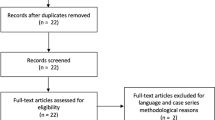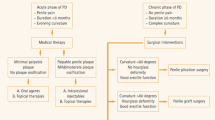Abstract
This study evaluated the long-term outcome of the Essed–Schroeder procedure for correcting congenital penile curvature using non-absorbable Goretex™ sutures. The Essed–Schroeder procedure was performed in 35 patients with congenital ventral penile curvature (minimum 30°). Follow-up included a standardized interview with measurement of angulation. Twenty-three of 35 patients were available for complete long-term follow-up (average 34.3 months). The mean preoperative ventral curvature was 54°. In 17/23 patients, the penis remained straightened. Recurrent curvature (average 23°) was observed in six of 23 patients. Fifteen of 23 patients complained of penile shortening (average 1.8 cm). Two of 23 patients reported disturbing side effects that were caused by plication nodes. In most cases, the results of penile straightening by the Essed–Schroeder procedure are excellent with a high grade of subjective satisfaction. Regarding the main problem, that is recurrent curvature, there is no decisive advantage of applying Goretex™ sutures. Discomfort caused by plication nodes can be reduced to a minimum by using a combination of soft Goretex™ sutures with the ‘inverting stitch-technique’.
This is a preview of subscription content, access via your institution
Access options
Subscribe to this journal
Receive 8 print issues and online access
$259.00 per year
only $32.38 per issue
Buy this article
- Purchase on Springer Link
- Instant access to full article PDF
Prices may be subject to local taxes which are calculated during checkout




Similar content being viewed by others
References
Nesbit RM . The surgical treatment of congenital chordee without hypospadia J Urol 1954 72: 1178–1180
Kelâmi A . Congenital penile curvature and its treatment with the Nesbit–Kelâmi technique Br J Urol 1987 60: 261–263
Licht MR, Lewis RW . Modified Nesbit procedure for the treatment of Peyronie's disease: a comparative outcome analysis J Urol 1997 158: 460–463
Yachia D . Modified corporoplasty for the treatment of penile curvature J Urol 1990 143: 80–82
Sassine AM, Wespes E, Schulman CC . Modified corporoplasty for penile curvature: ten years experience Urology 1994 44: 419–421
Popken G et al. A modified corporoplasty for treating congenital penile curvature and reducing the incidence of palpable induration BJU Int 1999 83: 71–75
Essed E, Schroeder FH . New surgical treatment for Peyronie's disease Urology 1985 25: 582–587
Schultheiss D et al. Congenital and acquired penile curvature treated with the Essed plication method Eur Urol 2000 38: 167–171
Knispel HH, Gonnermann D, Huland H . Modified surgical technique to correct congenital and acquired penile curvature Eur Urol 1991 20: 107–112
Manning M, Jünemann KP, Spahn M, Alken P . Operative Korrektur der Penisverkrümmung—Indikationen und Grenzen der Schröder–Essed-Technik Akt Urol 1999 30: 163–169
Vatne V, Hoeisaeter PA . Functional results after operations of penile curvatures: an institutional experience Scand J Urol Nephrol 1996 179: (Suppl) 151–154
Poulsen J, Kirkeby HJ . Treatment of penile curvature—a retrospective study of 175 patients operated with plication of the tunica albuginea or with the Nesbit procedure Br J Urol 1996 75: 370–374
Kelâmi A . Autophotography in evaluation of functional penile disorders Urology 1983 21: 628–629
Nooter RI, Bosch JLHR, Schröder FH . Peyronie's disease and congenital penile curvature: long-term results of operative treatment with plication procedure Br J Urol 1994 74: 497–500
Richter S, Shalev M, Nissenkorn I . Correction of congenital or acquired penile curvature through a simple corporoplication technique Int J Impot Res 1996 8: 255–258
Erpenbach K, Rothe H, Derschum W . The penile plication procedure: an alternative method for straightening penile curvature J Urol 1991 146: 1276–1278
Levine LA, Lenting EL . A surgical algorithm for the treatment of Peyronie's disease J Urol 1997 158: 2149–2152
Martinez-Portillo FJ et al. Comparison of Prolene vs Goretex® in patients undergoing the Essed plication procedure for congenital and acquired penile deviation Eur Urol 2001 39 (Suppl 5): 109 abstract 428
Author information
Authors and Affiliations
Corresponding author
Rights and permissions
About this article
Cite this article
Hauck, E., Bschleipfer, T., Diemer, T. et al. Long-term results of Essed–Schroeder plication by the use of non-absorbable Goretex™ sutures for correcting congenital penile curvature. Int J Impot Res 14, 146–150 (2002). https://doi.org/10.1038/sj.ijir.3900827
Received:
Accepted:
Published:
Issue Date:
DOI: https://doi.org/10.1038/sj.ijir.3900827
Keywords
This article is cited by
-
Current trends in the surgical treatment of congenital penile curvature
International Journal of Impotence Research (2020)
-
Plication Surgery for Peyronie’s Disease
Current Sexual Health Reports (2014)
-
Tunical plication in the management of penile curvature due La Peyronie’s disease. Our experience on 47 cases
BMC Surgery (2012)
-
Congenital Penile Curvature: Update and Management
Current Urology Reports (2012)
-
Upregulation of mRNA expression of MCP-1 by TGF-β1 in fibroblast cells from Peyronie’s disease
World Journal of Urology (2009)



